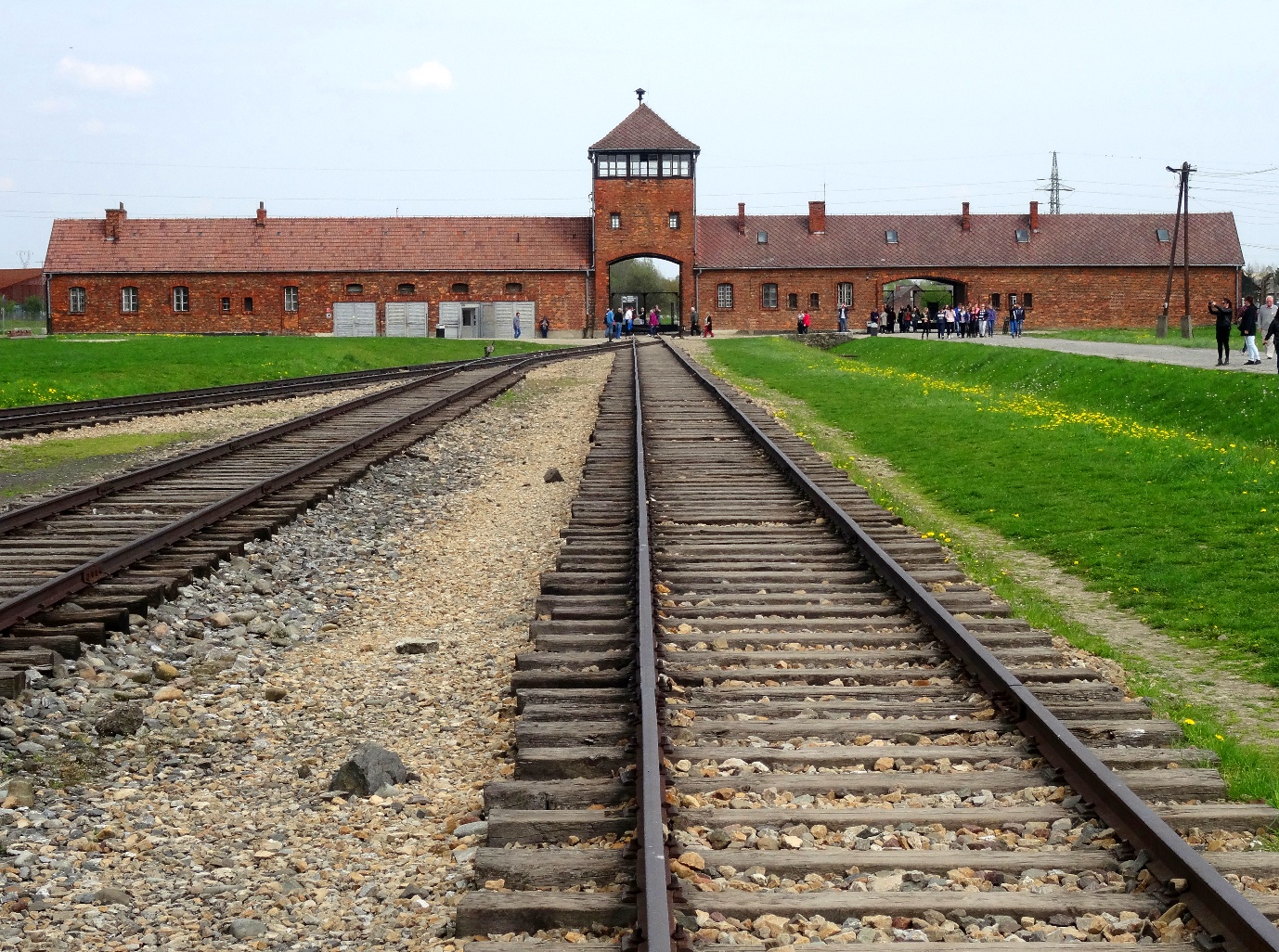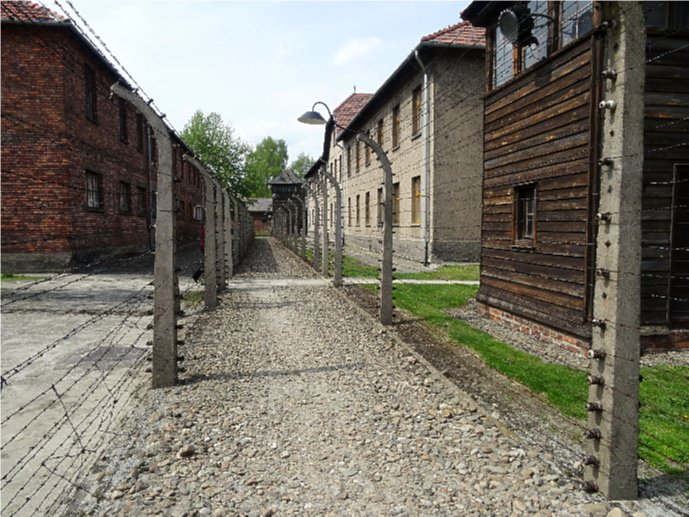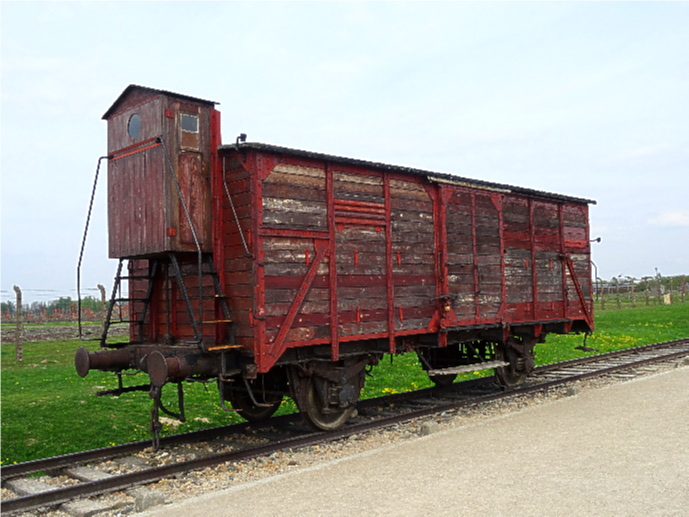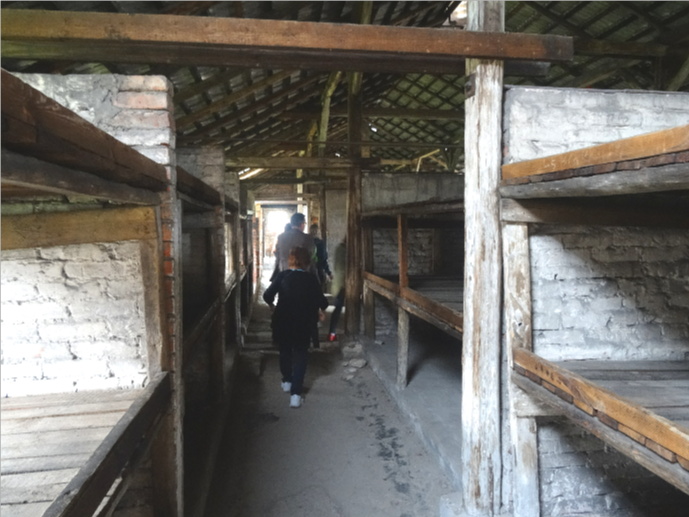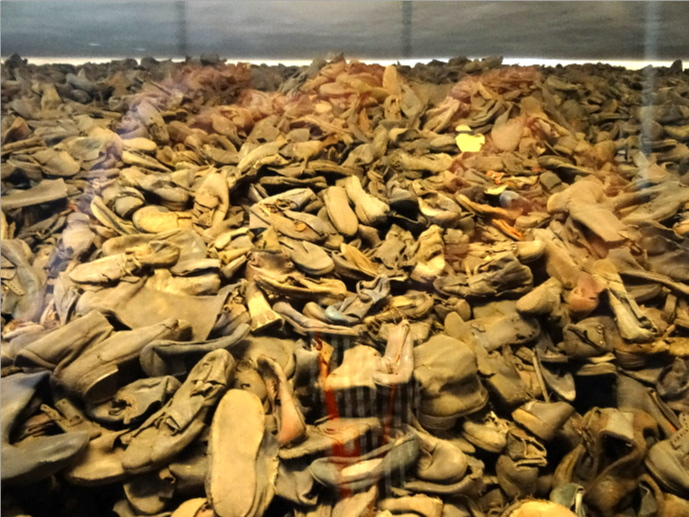Located seventy kilometres west of Krakow are the former Nazi Concentration and Extermination camps of Auschwitz and Birkenau which today form the Auschwitz and Birkenau Museum. Between June 1941 and January 1945 they were used by the Nazis as forced labour and extermination camps for thousands of people shipped there from all over Nazi occupied Europe. Many of the inhabitants were killed immediately on arrival while others were set to work in one of the subsidiary camps in the area, with many being either worked to death, starved or brutally killed. The camp had a capacity for 150,000 people and over one million men, women and children died in the three main camps and forty sub-camps.
With the advance of the Soviet Army into Poland in November 1944, Himmler ordered the extermination process to stop and the dismantling of Crematoria II, III, and IV, Crematorium I was transformed into an air raid shelter. Prior to it being abandoned, attempts had been made to destroy the evidence of what had been going on there. Steps were taken by the Nazis to destroy all evidence of the killings. The mass graves and all written records were destroyed. The crematoria were demolished - the ruins of which can be seen today.
The camp was liberated on the 27 January 1945 although 58,000 of the detainees had been evacuated ten days before and sent on what became a ‘death march’ to the Bergen-Belsen concentration camp. 38,000 died en route!
After the liberation, Auschwitz I served as a hospital for liberated prisoners. In the initial months, Soviet and Polish investigators documented the war crimes of the SS. In the following two years the Soviets dismantled and took some of the factories back to Russia and the Birkenau barracks were looted. Parts of the camp were used as a prison by the Soviets until they handed it over to Poland in 1947. On 2 July 1947, the site of Auschwitz I and II became a museum and the first exhibition in the barracks was opened. Exhumation work commenced in 1947 and lasted for over a decade.
Among the items found by the Soviets were 370,000 men's suits, 837,000 women's garments, and 7.7 tonnes of human hair, numerous pairs of shoes, suitcases, spectacles and artificial limbs, some of which can be seen in Auschwitz I together with many other personal effects. Also on display are canisters of Zyklon B pellets and a model to show the design of the gas chambers, all of which form the displays in the museum.
The exact number of victims at Auschwitz is difficult to determine with certainty, as many prisoners were never registered and much evidence was destroyed by the SS in the final days of the war. The corpses of many of those killed were burned, making it difficult to gain any accurate number. A display in Auschwitz estimates the number at 1,100,000, 90% of whom were Jews, with the majority of them being killed in the gas chambers.
Around 1.5 million people visit the museum each year. Visitors do need to be part of an organised group and therefore, individual visitors are grouped with an authorized guide who provides the tour in a number of languages.
The camp actually consisted of a number of camps although Auschwitz I and Auschwitz II – Birkenau form the museum.
Auschwitz I was the administrative centre for the whole complex. It was first constructed to hold Polish political prisoners, who started to arrive in May 1940. The gates to Auschwitz I displayed the motto “Arbeit macht frei” (Work brings freedom). The extermination of prisoners started in September 1941. Many of those who did not meet their deaths in the gas chambers died of starvation, forced labour, infectious diseases, individual executions, and medical experiments.
The camp consists of a number of Blocks which are visited on the tour. Block 11 was a punishment block. It contained a number of very small cells where some prisoners were made to spend the nights. These cells were about 1.5 m2 (16 sq ft), and held four men; the lack of space meant that they could not lie down but only stand, and these were known as the standing cells.
In the basement were the "dark cells", were people sentenced to death for attempting to escape were incarcerated. They were given neither food nor water and many suffocated due to the lack of oxygen. Outside, in the courtyard, stood the wall against which prisoners would be shot.
Also to be seen are the blocks where a wide variety of medical experiments were undertaken on prisoners. Many of these were undertaken by the infamous doctor Josef Mengele, known as the "Angel of Death".
There is a square where detainees would report twice a day and where they would remain until all were accounted for. There is a wooden frame where prisoners would be hanged, in order to make an example of them, and there is a wooden hut which allowed the inspecting officer to shelter from the rain.
The gas chambers and the crematoria can be seen and just outside is the gallows where camp Commandant Rudolf Höss, was executed following his war crimes trial after the war.
The distance between Auschwitz I and Birekenau is approximately 3km and there is a complementary shuttle bus to take visitors between the two sites. It is usual to first visit Auschwitz I and then move onto Auschwitz II.
Auschwitz II – Birkenau was constructed from October 1941 to ease congestion at Auschwitz I. It was intended to house 50,000 prisoners of war, who would be used as forced labour. By May 1942 Hitler had decided to annihilate the Jewish people, so the role of Birkenau was changed to a combination of labour / extermination camp and become a major site of the Nazi "Final Solution to the Jewish question".
From early 1942 until late 1944, transport trains delivered Jews to the camps in cramped carriages, (the like of which is on display) where they were selected for work or extermination. The first gas chamber at Birkenau became operational by March 1942 and anyone not able to work would be sent straight to the gas chamber where they were killed with what was originally a pesticide - Zyklon B. At least 1.1 million people died at Auschwitz, around 90 percent of them Jewish; approximately 1 in 6 Jews killed in the Holocaust died at the camp. Other groups sent to the camp included gypsies, Jehovah’s Witnesses, homosexuals, and Soviet prisoners of war.
Auschwitz II-Birkenau is where the frequently photographed camp frontage is seen with the railway lines passing through. This was where people were disembarked on arrival. They then underwent a brief assessment to determine if they were capable of working. Those who were deemed not to be fit were taken to the gas chamber where under the misapprehension of being taken to a shower block, they were gassed.
Those selected for work would be taken to the accommodation, some of which can still be seen. Auschwitz II camp contained 300, mainly wooden, barracks. The original wooden huts are no longer there, although a number have been reconstructed, including a toilet block, and some of the brick buildings can be seen and visited.
Today, there are a number of monuments to those who died in Auschwitz-Birkenau as the site is not solely a museum but it is very much a monument, a shrine and a place of education, and one which provides a very emotional visit.
